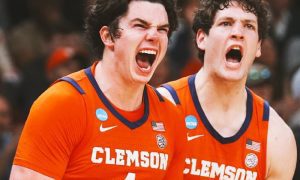[rps-paypal]
[ezcol_1half id=”” class=”” style=””]

SERIES LINKS
TABLE OF CONTENTS:
— General history
— J.F. “Pop” McKale
— The games
— Comparisons then and now
— Wildcats nickname
— Military service
— Rankings
— The players
[/ezcol_1half]
[ezcol_1half_end id=”” class=”” style=””]
Clipping of actual L.A. Times article published Nov. 8, 1914
Excerpt from L.A. Times, Nov. 8, 1914, authored by Bill Henry:
“Arizona’s cactus-fed athletes, despite heroic efforts on the part of their two halfbacks, (Asa) Porter and (Franklin) Luis, went down to defeat before the Occidental Tigers yesterday afternoon, the tally with all precincts heard from being 14 to 0 in favor of the Tigers.
Confident of rolling up a big score, the Tigers took the field with grins on their faces, but before the game was 10 seconds old they knew they had a battle on their hands.
The Arizona men showed the fight of wild cats and displayed before the public gaze a couple of little shrimps in the backfield who defied all attempts of the Tigers to stop them.”This site will conduct a countdown in a 100-day period, leading up to Arizona’s 2014 football season-opener with UNLV on Aug. 29 at Arizona Stadium. The 100 Days ‘Til Kickoff countdown will include information daily about the historic 1914 Arizona team that helped create the school’s nickname of “Wildcats” because of how they played that fateful day against Occidental.
[/ezcol_1half_end]

The drastic differences in sizes between the 1914 team and projected 2014 defensive starters (AllSportsTucson.com graphic)
[ezcol_1half id=”” class=”” style=””]
EDITOR NOTE: This blog was published earlier in our series. It updates to reflect that nose tackle Kirifi Taula is no longer on the current roster because of medical issues in June.
Arizona “Varsity” left end James Vinton Hammels was nicknamed “Brute” by coach J.F. “Pop” McKale because of his menacing size and physical style of play at 6’1″ and 163 pounds in 1914.
The captain of the team, left guard Turner Smith, was a tad larger at 6’1″ and 173 pounds.
Charles Beach, at right guard, was a tough son-of-a-gun, a rancher and a miner who also hunted wild desert life. Beach stood at 6’1″ and 170 pounds.
[/ezcol_1half]
[ezcol_1half_end id=”” class=”” style=””]
[/ezcol_1half_end]
A century later, the size of Hammels, Smith and Beach resembles the smallest position in football today (other than the placekicker) — cornerback. Arizona’s potential starting right cornerback, Devon Holiday, is the smallest defensive player listed in the depth chart at 5’10” and 156 pounds.
Holiday could have played fullback for McKale. Orville McPherson, nicknamed “Speedy” by his coach for his elusiveness in the backfield, played the physically demanding position of fullback 100 years ago. He was 5’9″ and 152 pounds, almost the same size as Holiday.
The anchor of Arizona’s attack in 1914 was center Emzy “Swede” Lynch, who was 5’11” and 165 pounds. If lined up against the Wildcats’ defensive front today, Lynch would encounter perhaps 6’1″ and 272-pound sophomore Dwight Melvin at nose tackle.
The average size of the Varsity starting lineup in 1914: 5’10.5″ and 159 pounds.
The average size of the Wildcats’ starting defense in 2014: 6’1.2″ and 217.5 pounds.
That’s a difference of about three inches of height and almost 60 pounds in weight.

The 1914 Arizona football team that earned the honor of being named the first “Wildcats” was composed of (front row, left to right): Verne La Tourette, George Seeley, Leo Cloud, Richard Meyer, Asa Porter. Second row: Franklin Luis, Lawrence Jackson, Ray Miller, J.F. “Pop” McKale (coach), Turner Smith, Harry Hobson (manager), Orville McPherson, Albert Crawford, Ernest Renaud. Back row: Albert Condron, Emzy Lynch, Charley Beach, Vinton Hammels, Bill Hendry, George Clawson, Harry Turvey.
(AllSportsTucson.com graphic/Photo from University of Arizona Library Special Collections)
[ezcol_1half id=”” class=”” style=””]
When Arizona’s nickname of the “Wildcats” was created — in Bill Henry’s Arizona-Occidental game story in the Los Angeles Times on Nov. 8, 1914 — two players were described as “little shrimps”. They were Arizona halfbacks Asa Porter (5’7″ and 146 pounds) and Franklin Luis (5’6″ and 149).
If Porter and Luis were “shrimps” back then, they are tadpoles today.
The obvious differences from 1914 and today are the evolution of protein-rich diets and supplements and the improvement of weight-training equipment and fitness regimens.
The weight-training facility that existed at Arizona in 1914 was a small room in the basement of Herring Hall. The massive weight room at the new Lowell-Stevens Football Facility looks like the Taj Mahal in comparison.
[/ezcol_1half]
[ezcol_1half_end id=”” class=”” style=””]
[/ezcol_1half_end]

This December 1913 edition of “Physical Culture” magazine introduced readers to the use of a barbell
The total workout equipment at Herring Hall cost $1,500, according to the Report of the Governor of Arizona to the Secretary of the Interior. The facility included 96 lockers, chest weights, dumb bells, bar bells, vaulting horse, parallel bars, horizontal bars, abdominal chair, striking bag and drum, wrestling machine, wrist machine, finger machine, chest developer, chest expander and climbing rope, among other items.
Weight resistance equipment was not produced until the 1950s. Treadmills were not used until the 1960s.
Over the years, exercise machinery has advanced to the point of reading body-fat measurements. Muscle-specific resistance equipment allows for advanced conditioning.
A good diet for a football player in 1914 was eggs, milk and steak. Meal-replacement protein drinks and power bars have only existed in the last 20 years.
The simple consumption of water also plays a part in players being much larger today than 100 years ago.
A study published in the “Journal of Strength and Conditioning Research,” reports that a 1.5 percent decrease in water loss resulted in a decrease of muscle strength of the one rep max bench press. Therefore, given that such a small amount of water loss can compromise strength, staying hydrated can help you keep your strength and gain muscle over the long haul.
Safe water drinking laws were not enforced in the United States until 40 years ago. Drinking water out of a tap was not as popular of an idea as it is to drink purified water out of bottles now. The bottled water industry in America took off in the late 1990s.
Gatorade was an advancement for athletes from drinking water in the mid-1960’s. The beverage was first developed by a team of researchers at University of Florida, to replenish the combination of water, carbohydrates, and electrolytes that the school’s student-athletes lost in sweat during rigorous athletic competitions. Gatorade and drinks of its kind of evolved over the last 30 years.
I’ve stayed away from the touchy subject of performance-enhancing drugs. Athletes are tested regularly today. I’ll leave it at that.
ALLSPORTSTUCSON.com publisher, writer and editor Javier Morales is a former Arizona Press Club award winner. He also writes articles for Bleacher Report and Lindy’s College Sports.























